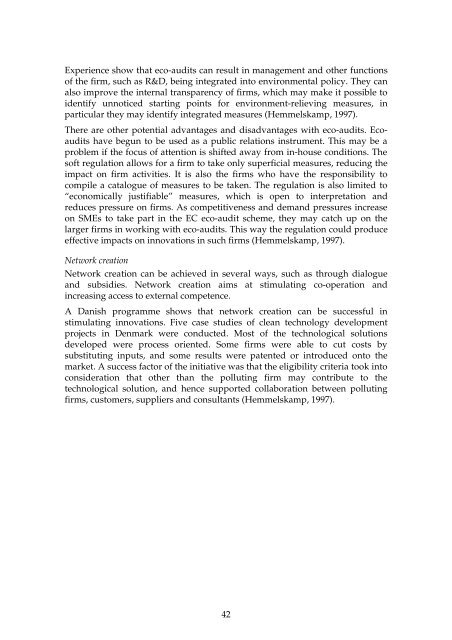Drivers of environmental innovation - Vinnova
Drivers of environmental innovation - Vinnova
Drivers of environmental innovation - Vinnova
You also want an ePaper? Increase the reach of your titles
YUMPU automatically turns print PDFs into web optimized ePapers that Google loves.
Experience show that eco-audits can result in management and other functions<br />
<strong>of</strong> the firm, such as R&D, being integrated into <strong>environmental</strong> policy. They can<br />
also improve the internal transparency <strong>of</strong> firms, which may make it possible to<br />
identify unnoticed starting points for environment-relieving measures, in<br />
particular they may identify integrated measures (Hemmelskamp, 1997).<br />
There are other potential advantages and disadvantages with eco-audits. Ecoaudits<br />
have begun to be used as a public relations instrument. This may be a<br />
problem if the focus <strong>of</strong> attention is shifted away from in-house conditions. The<br />
s<strong>of</strong>t regulation allows for a firm to take only superficial measures, reducing the<br />
impact on firm activities. It is also the firms who have the responsibility to<br />
compile a catalogue <strong>of</strong> measures to be taken. The regulation is also limited to<br />
“economically justifiable” measures, which is open to interpretation and<br />
reduces pressure on firms. As competitiveness and demand pressures increase<br />
on SMEs to take part in the EC eco-audit scheme, they may catch up on the<br />
larger firms in working with eco-audits. This way the regulation could produce<br />
effective impacts on <strong>innovation</strong>s in such firms (Hemmelskamp, 1997).<br />
Network creation<br />
Network creation can be achieved in several ways, such as through dialogue<br />
and subsidies. Network creation aims at stimulating co-operation and<br />
increasing access to external competence.<br />
A Danish programme shows that network creation can be successful in<br />
stimulating <strong>innovation</strong>s. Five case studies <strong>of</strong> clean technology development<br />
projects in Denmark were conducted. Most <strong>of</strong> the technological solutions<br />
developed were process oriented. Some firms were able to cut costs by<br />
substituting inputs, and some results were patented or introduced onto the<br />
market. A success factor <strong>of</strong> the initiative was that the eligibility criteria took into<br />
consideration that other than the polluting firm may contribute to the<br />
technological solution, and hence supported collaboration between polluting<br />
firms, customers, suppliers and consultants (Hemmelskamp, 1997).<br />
42

















